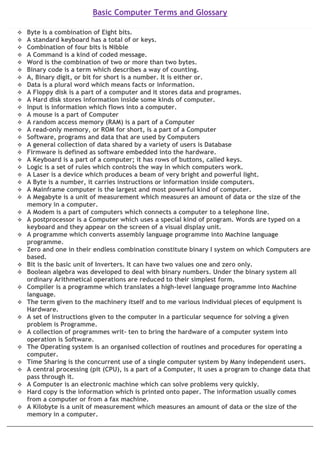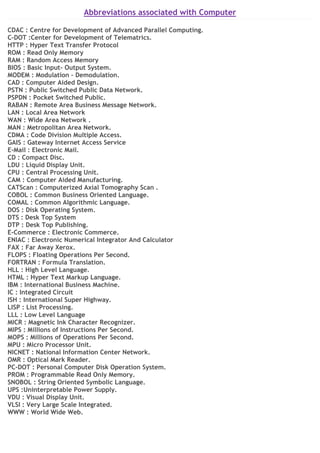Computer
- 1. Basic Computer Terms and Glossary ïķ Byte is a combination of Eight bits. ïķ A standard keyboard has a total of or keys. ïķ Combination of four bits is Nibble ïķ A Command is a kind of coded message. ïķ Word is the combination of two or more than two bytes. ïķ Binary code is a term which describes a way of counting. ïķ A, Binary digit, or bit for short is a number. It is either or. ïķ Data is a plural word which means facts or information. ïķ A Floppy disk is a part of a computer and it stores data and programes. ïķ A Hard disk stores information inside some kinds of computer. ïķ Input is information which flows into a computer. ïķ A mouse is a part of Computer ïķ A random access memory (RAM) is a part of a Computer ïķ A read-only memory, or ROM for short, is a part of a Computer ïķ Software, programs and data that are used by Computers ïķ A general collection of data shared by a variety of users is Database ïķ Firmware is defined as software embedded into the hardware. ïķ A Keyboard is a part of a computer; it has rows of buttons, called keys. ïķ Logic is a set of rules which controls the way in which computers work. ïķ A Laser is a device which produces a beam of very bright and powerful light. ïķ A Byte is a number, it carries instructions or information inside computers. ïķ A Mainframe computer is the largest and most powerful kind of computer. ïķ A Megabyte is a unit of measurement which measures an amount of data or the size of the memory in a computer. ïķ A Modem is a part of computers which connects a computer to a telephone line. ïķ A postprocessor is a Computer which uses a special kind of program. Words are typed on a keyboard and they appear on the screen of a visual display unit. ïķ A programme which converts assembly language programme into Machine language programme. ïķ Zero and one in their endless combination constitute binary I system on which Computers are based. ïķ Bit is the basic unit of Inverters. It can have two values one and zero only. ïķ Boolean algebra was developed to deal with binary numbers. Under the binary system all ordinary Arithmetical operations are reduced to their simplest form. ïķ Compiler is a programme which translates a high-level language programme into Machine language. ïķ The term given to the machinery itself and to me various individual pieces of equipment is Hardware. ïķ A set of instructions given to the computer in a particular sequence for solving a given problem is Programme. ïķ A collection of programmes writ- ten to bring the hardware of a computer system into operation is Software. ïķ The Operating system is an organised collection of routines and procedures for operating a computer. ïķ Time Sharing is the concurrent use of a single computer system by Many independent users. ïķ A central processing (pit (CPU), is a part of a Computer, it uses a program to change data that pass through it. ïķ A Computer is an electronic machine which can solve problems very quickly. ïķ Hard copy is the information which is printed onto paper. The information usually comes from a computer or from a fax machine. ïķ A Kilobyte is a unit of measurement which measures an amount of data or the size of the memory in a computer.
- 2. Abbreviations associated with Computer CDAC : Centre for Development of Advanced Parallel Computing. C-DOT :Center for Development of Telematrics. HTTP : Hyper Text Transfer Protocol ROM : Read Only Memory RAM : Random Access Memory BIOS : Basic Input- Output System. MODEM : Modulation â Demodulation. CAD : Computer Aided Design. PSTN : Public Switched Public Data Network. PSPDN : Pocket Switched Public. RABAN : Remote Area Business Message Network. LAN : Local Area Network WAN : Wide Area Network . MAN : Metropolitan Area Network. CDMA : Code Division Multiple Access. GAIS : Gateway Internet Access Service E-Mail : Electronic Mail. CD : Compact Disc. LDU : Liquid Display Unit. CPU : Central Processing Unit. CAM : Computer Aided Manufacturing. CATScan : Computerized Axial Tomography Scan . COBOL : Common Business Oriented Language. COMAL : Common Algorithmic Language. DOS : Disk Operating System. DTS : Desk Top System DTP : Desk Top Publishing. E-Commerce : Electronic Commerce. ENIAC : Electronic Numerical Integrator And Calculator FAX : Far Away Xerox. FLOPS : Floating Operations Per Second. FORTRAN : Formula Translation. HLL : High Level Language. HTML : Hyper Text Markup Language. IBM : International Business Machine. IC : Integrated Circuit ISH : International Super Highway. LISP : List Processing. LLL : Low Level Language MICR : Magnetic Ink Character Recognizer. MIPS : Millions of Instructions Per Second. MOPS : Millions of Operations Per Second. MPU : Micro Processor Unit. NICNET : National Information Center Network. OMR : Optical Mark Reader. PC-DOT : Personal Computer Disk Operation System. PROM : Programmable Read Only Memory. SNOBOL : String Oriented Symbolic Language. UPS :Uninterpretable Power Supply. VDU : Visual Display Unit. VLSI : Very Large Scale Integrated. WWW : World Wide Web.
- 3. Some others abbreviations suggested by Mohammed Rafi: WLAN â Wireless Local Area Network. Wi-fi â Wireless Fidelity TIFF â Tagged Image File Format e-SATA â External Serial Advanced Technology Attachment WiMAX â Worldwide Interoperability for Microwave Access JPEG â Joint Photographic Experts Group GIF â Graphics Interchange Format ATX â Advanced Technology Extended UATX â Ultra Advanced Technology Extended FATX â Flex Advanced Technology Extended MATX â Micro Advanced Technology Extended EEATX â Enhanced Extended Advanced Technology Extended DDR SDRAM â Double-Data-Rate Synchronous Dynamic Random Access Memory DDR RAM â Double-Data-Rate Random Access Memory GUI â Graphical User Interfaces CUI â Command User Interfaces If you know some other terms and abbreviations relted to computer, you can have a comment on the post so that can be added to the list. List of top Web Search Engines Year Engine Event 1993 Aliweb Launch WebCrawler Launch 1994 Infoseek Launch Lycos Launch AltaVista Launch Open Text Web Launch Index 1995 Magellan Launch Excite Launch SAPO Launch Dogpile Launch Inktomi Founded 1996 HotBot Founded Ask Jeeves Founded Northern Light Launch 1997 Yandex Launch 1998 Google Launch AlltheWeb Launch GenieKnows Founded 1999 Naver Launch Teoma Founded
- 4. Vivisimo Founded 2000 Baidu Founded 2003 Info.com Launch Yahoo! Search Final launch 2004 A9.com Launch MSN Search Final launch 2005 Ask.com Launch GoodSearch Launch wikiseek Founded Quaero Founded Ask.com Launch 2006 Live Search Launch ChaCha Beta Launch Guruji.com Beta Launch wikiseek Launched 2007 Wikia Search Launched Powerset Launched Viewzi Launched 2008 Cuil Launched Boogami Launched LeapFish Beta Launch




